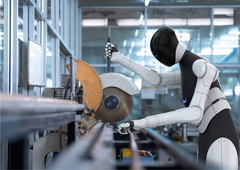U.S. Lags China in Factory Robot Deployment by 5 to 1 Ratio
By:
PR Leap
September 25, 2025 at 08:05 AM EDT
 (PRLeap.com)
(PRLeap.com) Frankfurt, September 25th, 2025 - The new World Robotics report recorded 393,700 industrial robots working in US factories - an increase of 3% year-on-year. Annual installations reached 34,200 units in 2024 - down 9%, but 30% higher compared to ten years ago. Nevertheless, the US has growth potential: China, the world's largest market for industrial robots, has five times more operational stock than the US.
"The United States is highly automated running the third-largest stock of industrial robots worldwide, behind only Japan and China,' says Takayuki Ito, president of the International Federation of Robotics. 'However, a comparison of the US and China reveals the enormous automation potential of the world's largest economy by GDP."
With annual installations ranging from 26,200 to 40,400 units, the United States is in line with other leading adopters, such as South Korea, Germany, and Japan. But China installed 295,000 industrial robots in 2024, which is almost nine times more than the United States.
A long-term perspective confirms the automation gap: In 2024, China had around five times more factory robots in use (2,027,200) than the US (393,700 units). This development is based on China's national robotics strategy released in December 2021, with the aim of enhancing competitiveness.
National Robotics strategy
The Association for Advancing Automation (A3) strongly advocates for a national robotics strategy in the United States. Its comprehensive vision outline, released in 2025, sets out key policy recommendations for maintaining global competitiveness. This must take into account the structural differences, such as the fact that most U.S. robot hardware is imported from Japan and Europe. The situation is different in China, where 57% of the market is served by domestic manufacturers.
In addition, Chinese manufacturers are leading the way in the adoption of robotics automation in new customer industries, extending the reach of robotics beyond the traditional domains of the automotive, metal/machinery, and electro/electronics sectors.
U.S. Customer Industries
In the US, the traditional customer industry automotive remains by far the largest customer market, accounting for 40% of total US installations in 2024: Sales rose by 11% to 13,600 units. On a global scale, the United States has the second largest production volume of cars and light vehicles, following China.
The metal and machinery industry installed 3,500 units - down 15%. The US electrical/electronics industry went down by 23% at 2,800 units newly installed. Robot installations in the food and beverage industry gained 21% to 2,200 units in 2024.
Canada and Mexico
In Canada, robot demand from the automotive industry went down 28% to 1,800 units, accounting for 47% of total installations in 2024. Installations across all industries declined by 12% to 3,800 units. Canada has close ties to the US economy and is thus strongly affected by US tariffs. The automotive industry has cancelled many major investment projects due to policy uncertainty. Robot installations in Canada are, therefore, expected to further decline.
In Mexico, demand from the automotive industry declined by 11% to 3,500 units in 2024. This segment accounts for 63% of total installations. Installations across all industries declined by 4% to 5,600 units, continuing the downswing of the previous year.
Outlook
Uncertainty and trade tensions will be a burden for the US robotics market in the short term. In the long run, reshoring production and labor scarcity will provide excellent opportunities for robotics and the overall expectation is positive. Robot installations are expected to grow in 2025 and beyond.
Press release in English and German language and picture can be downloaded at: https://ifr.org/ifr-press-releases/
About IFR
The International Federation of Robotics is the voice of the global robotics industry. IFR represents national robot associations, academia, and manufacturers of industrial and service robots from over twenty countries: www.ifr.org
Follow IFR on LinkedIn and YouTube
GET IN TOUCH
Carsten Heer
International Federation of Robotics
+49 (0) 40 822 44 284
http://www.ifr.org
You can see the original version and more on PRLeap here: http://www.prleap.com/pr/307112/us-lags-china-in-factory-robot-deployment-by-5-to-1-ratio
More News
View More

Affirm Just Crushed Earnings—But Can It Outrun Klarna’s Scale? ↗
Today 12:39 EST
Via MarketBeat

4 High-Risk Growth Stocks Under $15 to Watch This Fall ↗
Today 11:13 EST

Walmart Stock Surges After a Solid Q3—Stronger Growth Ahead ↗
Today 10:22 EST
Via MarketBeat

Microsoft’s AI Superfactory Could Power a Stock Rally ↗
Today 9:27 EST
Recent Quotes
View More
Stock Quote API & Stock News API supplied by www.cloudquote.io
Quotes delayed at least 20 minutes.
By accessing this page, you agree to the Privacy Policy and Terms Of Service.
Quotes delayed at least 20 minutes.
By accessing this page, you agree to the Privacy Policy and Terms Of Service.
© 2025 FinancialContent. All rights reserved.
>